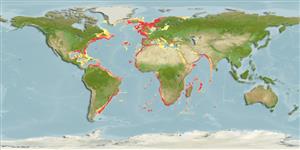Preferred temperature (Ref.
115969): 4 - 18.1, mean 10.6 (based on 1236 cells).
Fylogenetische diversiteitsindex (Ref.
82804): PD
50 = 0.5020 [Uniqueness, from 0.5 = low to 2.0 = high].
Bayesian length-weight: a=0.01047 (0.00911 - 0.01203), b=3.08 (3.04 - 3.12), in cm Total Length, based on LWR estimates for this species (Ref.
93245).
Trofisch niveau (Ref.
69278): 3.5 ±0.0 se; based on diet studies.
Weerstandsvermogen (Ref.
120179): laag, minimale populatieverdubbelingstijd 4,5-14 jaar (K=0.06-0.2; tm=13-16; tmax=43).
Prior r = 0.40, 95% CL = 0.27 - 0.61, Based on 1 stock assessment.
Fishing Vulnerability (Ref.
59153): High to very high vulnerability (68 of 100).
